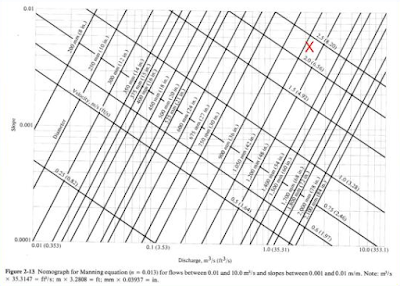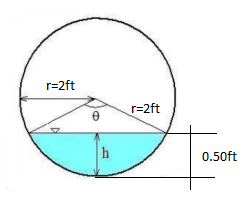Considering friction loss as the major loss of head in pipes, there are also some minor losses present. These minor losses affect the velocity of the flow, thus they become deviations of the velocity head. They come from various conditions:
- Contraction
- Enlargement
- Gate
- Bend
- Change in direction
- Obstructions
6.6.1. LOSS OF HEAD DUE TO CONTRACTION
Sudden contraction of the pipe size can cause head loss, in which it is equated as below:
where:
V = velocity in the smaller pipe
Values of the coefficient Kc for sudden contraction (English units) are tabulated as follows. Interpolation is required for exact values.
| VELOCITY IN SMALLER PIPE, V | RATIO OF | SMALLER | TO | LARGER | DIAMETER | |||||
|---|---|---|---|---|---|---|---|---|---|---|
| 0.0 | 0.1 | 0.2 | 0.3 | 0.4 | 0.5 | 0.6 | 0.7 | 0.8 | 0.9 | |
| 2 | 0.49 | 0.49 | 0.48 | 0.45 | 0.42 | 0.38 | 0.28 | 0.18 | 0.07 | 0.03 |
| 5 | 0.48 | 0.48 | 0.47 | 0.44 | 0.41 | 0.37 | 0.28 | 0.18 | 0.09 | 0.04 |
| 10 | 0.47 | 0.46 | 0.45 | 0.43 | 0.40 | 0.36 | 0.28 | 0.18 | 0.10 | 0.04 |
| 20 | 0.44 | 0.43 | 0.42 | 0.40 | 0.37 | 0.33 | 0.27 | 0.19 | 0.11 | 0.05 |
| 40 | 0.38 | 0.36 | 0.35 | 0.33 | 0.31 | 0.29 | 0.25 | 0.20 | 0.13 | 0.06 |
*Values of the coefficient for sudden contractions will be much smaller.
A different case for sudden contraction is used for pipe entrances. The formula for the loss of head at pipe entrance is as follows:
where: Cv = coefficient of velocity
| ENTRANCE TO PIPE | Cv |
|---|---|
| Inward projecting | 0.75 |
| Square cornered | 0.82 |
| Slightly rounded | 0.90 |
| Bell mouth | 0.95 |
EXAMPLE 6.6.1.1. EXAMPLE OF HEAD LOSS DUE TO SUDDEN CONTRACTION
EXAMPLE 6.6.1.2. EXAMPLE OF HEAD LOSS DUE TO SUDDEN CONTRACTION
6.6.2. LOSS OF HEAD DUE TO ENLARGEMENT
The enlargement of the pipe's cross section would cause the reduction in velocity. The loss of head due to sudden enlargement is given in the formula:
where: velocity head is taken from the smaller pipe;
Ke is identified by Archer as:
The case of sudden enlargement from pipe to a reservoir is a special case in which the ratio of diameters is taken as zero.
EXAMPLE 6.6.2.1. EXAMPLE OF HEAD LOSS DUE TO SUDDEN ENLARGEMENT
EXAMPLE 6.6.2.2. EXAMPLE OF HEAD LOSS DUE TO SUDDEN ENLARGEMENT
6.6.3. LOSS OF HEAD DUE TO OBSTRUCTIONS
6.6.3.1. GATES OR VALVES PARTIALLY CLOSED
Loss of head can also happen due to partially closed gates or valves. Head loss due to obstruction follows similar formula with the velocity head as the others:
Loss of head can also happen due to partially closed gates or valves. Head loss due to obstruction follows similar formula with the velocity head as the others:
where: V = mean velocity in the pipe
| Diameter of valve, inches | Ratio of | opening | to | diameter | , d/D | |
|---|---|---|---|---|---|---|
| 1/8 | 1/4 | 3/8 | 1/2 | 3/4 | 1 | |
| 1/2 | 450 | 60 | 22 | 11 | 2.2 | 1 |
| 3/4 | 310 | 40 | 12 | 5.4 | 1.1 | 0.29 |
| 1 | 230 | 32 | 9 | 4.1 | 0.9 | 0.23 |
| 1-1/2 | 170 | 23 | 7.2 | 3.3 | 0.75 | 0.18 |
| 2 | 140 | 20 | 6.5 | 3 | 0.68 | 0.16 |
| 4 | 92 | 16 | 5.5 | 2.6 | 0.55 | 0.14 |
| 6 | 73 | 14 | 5.3 | 2.4 | 0.49 | 0.12 |
| 8 | 66 | 13 | 5.2 | 2.3 | 0.46 | 0.1 |
| 12 | 56 | 12 | 5.1 | 2.2 | 0.42 | 0.07 |
6.6.3.2. OBSTRUCTION IN A PIPE
For an obstruction inside the pipe, the head loss will be as follows:
where: A = area of pipe
a = largest area of obstruction
Cc = coefficient of contraction
V = velocity of flow in pipe






